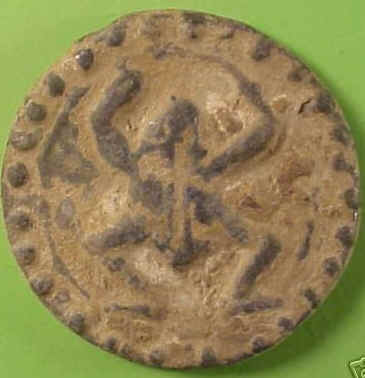
Burmese (Myanmar) Lead coin issued by the Kingdom of Pyu about 500-800 AD. With Frog. Most Pyu coins have the sacred Hintha bird but I was able to buy two with a frog. I have seen less than six with frogs in seventeen visits over twenty years. Crude. Reverse blank. About 30 mm. 15.52 grams. Lead was used as money for many centuries in Burma, up until 1885.
US $61.05 (euro 48,75), Feb-16-05, ebay, neilsowards
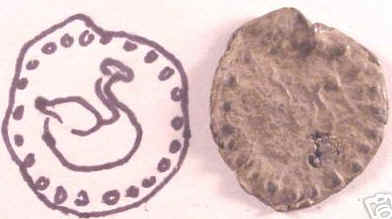
Burmese (Myanmar) Lead coin issued by the Kingdom of Pyu after 800 AD. With Hintha or sacred bird right. Reverse blank. About 18 mm. 2.3 grams. Lead was used as money for many centuries in Burma, up until 1885. This coin is much thinner and lighter than most of the lead coins I have seen in Burma and I think much scarcer. Being lighter I think they were made later--after 800 A.D. while the heavy ones were made 500-800 AD.
US $9.99 (euro 7,98) geen biedingen, Feb-16-05, ebay, neilsowards
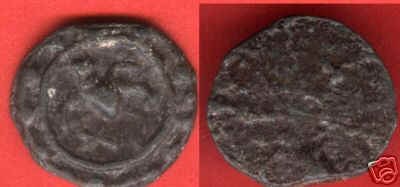
These coins were used in the area of Burma and North Thailand when the Post-Funan era left a power vaccuum that spurred several power areas in the SE Asian area. This lead money is 2.3 cm wide, 1-2 mm thick and weighs 8 grams, consistent with the coins of the era. However, this design is not one in my book. It is not a copy as it has marks that show wear over a long period of time, and I got it at a place years ago when copy coins were not heard of.
US $15,99 (EUR 12,38) 28-mrt-05, ebay, trader55553
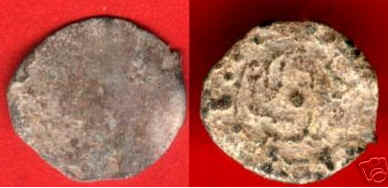
US $11,99 (EUR 9,99), 25-jul-05, ebay, trader55553
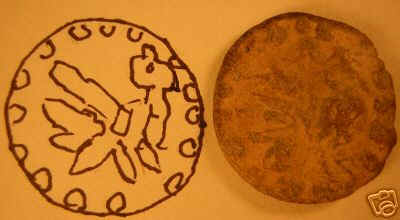
US $9,99 ( EUR 8,32) niet verkocht, 16-jul-05, ebay, neilsowards

US $9,99 ( EUR 8,32) niet verkocht, 16-jul-05, ebay, neilsowards
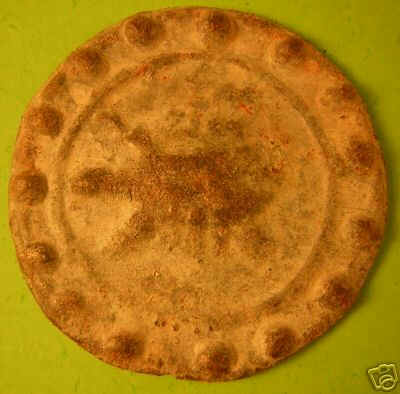
US $20.50 (EUR 16,62) 3-jul-05, ebay, neilsowards
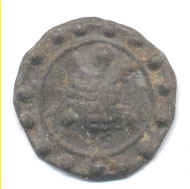
US $26.00 (euro 21) Jun-25-05, ebay, godzila8
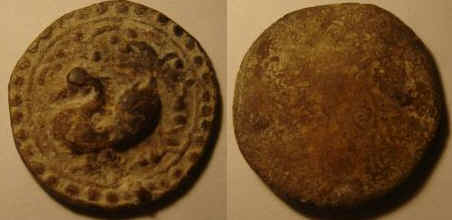
A Pegu lead coin from
southern Burma. These coins were first issued around AD1560 possibly under the reign of
King Bayinnaung and were in use until the early 1700s. fine detail of a hintha bird,
perhaps with foliage in a circle of dots. The hintha bird was an emblem used in the
ancient Mon kingdom in south Burma and is also found on many Burmese opium weights. It has
been suggested that the hintha bird is actually a Brahmani duck. There appears to be
confusion on e-bay about these coins. They are not Pyu coins. Pyu coins were silver coins
dating from some 800years before these lead coins were produced.
Diameter : 2.6cm / 1inch
Weight: approx. 9g
GBP 62,00 ( EUR 90,88) 23-aug-05, ebay, shwenaga
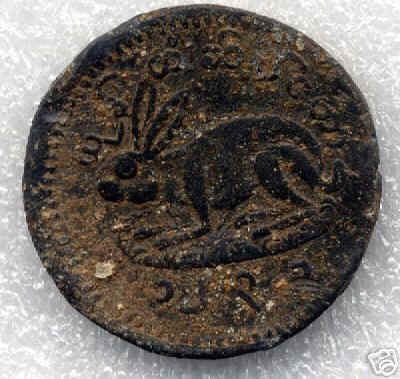
OBV: Hare (Rabbit) Facing Left with inscription and Date
The Burmese People belived that there was a Hare (Rabbit) living on the Moon as such the Hare apears on the OBV of the 1/16 Pe, the same is also said for the Peacock as it was said to be in the Sun, it would be a Rosted Peacock for sure.
REV: Value within wreath
Details still clear, and Rare this Nice R&S 11.15
GBP 10,50 (EUR 15,39) 18-aug-05, ebay, 16jwoc
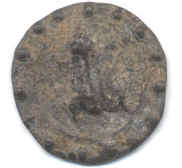
Ancient Burma lead coin with frog design; I got it from a dealer along the Thai-Burma border who said it was excavated from the area of ancient Mon kingdom in present day Myanmar.
US $53,55 (EUR 43,50) 10-aug-05, ebay, godzila8
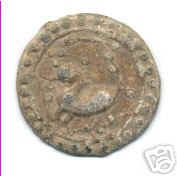
US $15,00 (EUR 12,40), 04-sep-05, ebay, godzila8
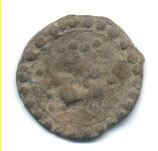
US $12,00 (EUR 9,92), 04-sep-05, ebay, godzila8
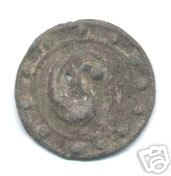
US $9,99 (EUR 8,26), 04-sep-05, ebay, godzila8

GBP 12,50 (EUR 18,49), 02-nov-05, ebay, shwenaga
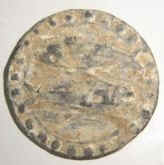
GBP 16,00 (EUR 23,67), 02-nov-05, ebay, shwenaga
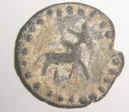
GBP 9,05 (EUR 13,33), 16-okt-05, ebay, shwenaga
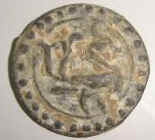
GBP 5,99 (EUR 8,82), 16-okt-05, ebay, shwenaga
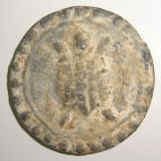
GBP 42,10 (EUR 62,02), 20-okt-05, ebay, shwenaga
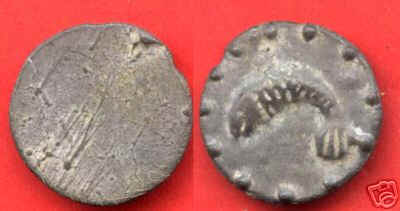
US $16,99 (EUR 13,34), niet verkocht, 3 april 2006, trader55553
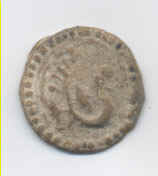
US $9,99 (EUR 7,85), 19-apr-06, ebay, godzila8
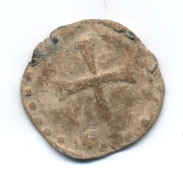
US $31,05 (EUR 24,39), 19-apr-06, ebay, godzila8
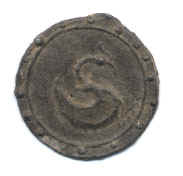
US $8,00 (EUR 6,28), 20-apr-06, ebay, godzila8
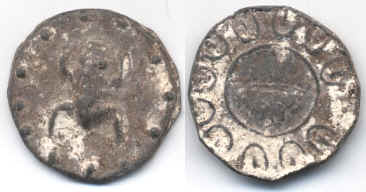
US $44,00 (EUR 34,56), 20-apr-06, ebay, godzila8
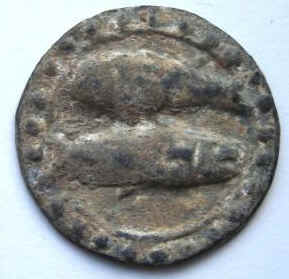
Pegu lead coins are normally found with hintha birds on the obverse. This 'double fish' coin comes from a series of coins that are far rarer than the bird coins, featuring animals, including cows, frogs, shrimps, crocodiles and turtles.
Diameter: 30mm
GBP 7,00 (EUR 10,22), niet verkocht, 11-mei-06, ebay, shwenaga
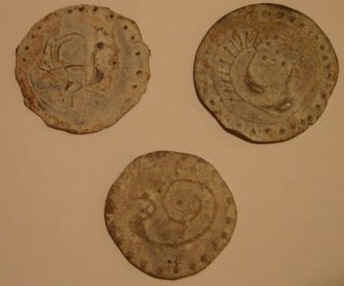
These coins are much rarer than the Pegu hintha coins (often incorrectly labelled as 'Pyu coins' on ebay) and possess a delicate beauty. I am selling them together as i feel it would be a shame to separate them.
Diameters: 26mm, 25mm and 23mm
GBP 11,00 (EUR 16,06), 04-mei-06, ebay, shwenaga
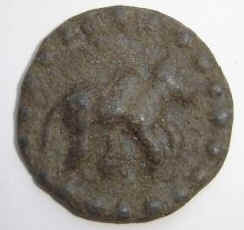
Pegu lead coins are normally found with hintha birds on the obverse. This 'bull' coin comes from a series of coins that are far rarer than the bird coins, featuring animals, including cows, frogs, crocodiles and turtles. I've seen this series in three sizes, this coin being of the middle size.
GBP 9,00 (EUR 13,04), 15-mei-06, ebay, shwenaga
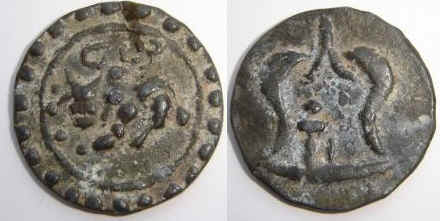
The design on the coin remains consistent with the Chandras dynasty in that the obverse shows a humped bull with garland (facing left) and an inscription above the bull - probably the name of the king at the time. There is a circle and a ring of dots around this image.
The reverse shows a Srivatsa (Temple of Sri - the fertility goddess) often found on Rakhine and Pyu coins. Within the Srivatsa is a linga.
Diameter: 32mm
GBP 19,50 (EUR 28,25), 15-mei-06, ebay, shwenaga
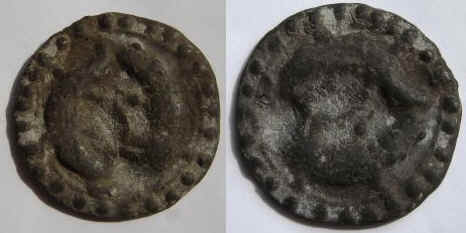
The animal series coins come in at least two sizes, namely the smaller size of 28mm - 30mm and the larger size of 38mm - 40mm. This is one of the large coins and shows two crocodiles forming a circle with one's head facing the other's tail. The crocodiles are within a circle of dots. The reverse is blank.
Diameter : 39mm
GBP 7,50 (EUR 10,86), 08-mei-06, ebay, shwenaga
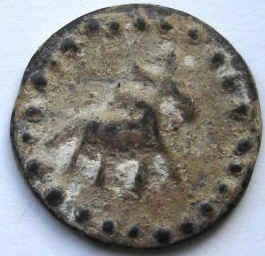
GBP 16,50 (EUR 23,90), 10-mei-06, ebay, shwenaga
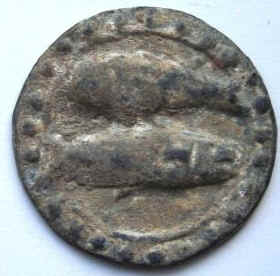
Pegu lead coins are normally found with hintha birds on the obverse. This 'double fish' coin comes from a series of coins that are far rarer than the bird coins, featuring animals, including cows, frogs, shrimps, crocodiles and turtles.
Diameter: 30mm
GBP 21,00 (EUR 30,42) , 10-mei-06, ebay, shwenaga
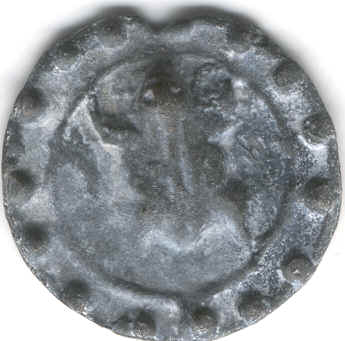
Burma lead coin Kingdom of Pygu with frog 1550-1590
vz: kikker
kz: blanco
27,17 mm, 26,14, 4,33 mm dik 30 mm. 9,46 gram.
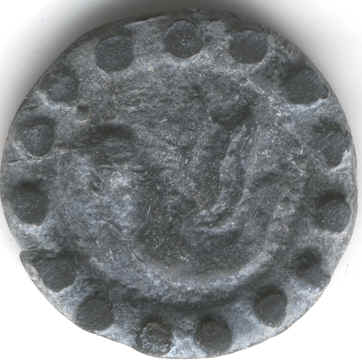
Burma lead coin Kingdom of Pygu with swan 1550-1590
vz: zwaan
kz: leeg
28,05 mm, 28,51 mm, 2,99 mm dik, 14,60 gram
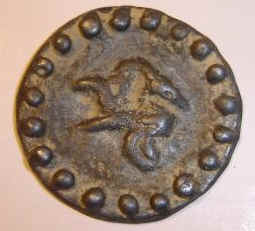
One of the largest lead coins from a series of coins featuring hintha birds from the region near Bago in the south of Burma (Myanmar). The obverse shows a hintha facing right with a long crest and upright tail. The bird is encircled by a ring of dots. The reverse is blank. The coin dates to the 16th/17th century.
Diameter: 44mm
GBP 9,50 (EUR 14,18), 03-jan-07, ebay, shwenaga
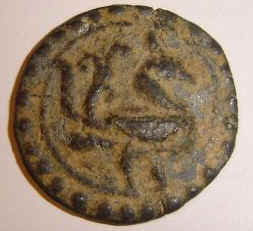
A lead coin from a series of coins featuring hintha birds from the region near Bago in the south of Burma (Myanmar). The obverse shows a beautiful representation of the hintha facing right with a long crest and an elaborate tail. The bird is encircled by a ring of dots. The reverse is blank. The coin dates to the 16th/17th century.
Diameter: 29mm
GBP 17,01 (Ongeveer EUR 25,39), 02-jan-07, ebay, shwenaga
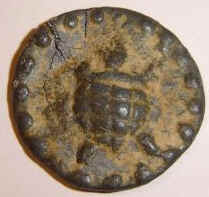
Lead coin from the region around Bago in the south of Burma. The obverse shows a turtle with four flippers and head exposed with markings on its shell. The turtle is encircled by a ring of dots. The reverse is blank. This coin is from a series of lead coins featuring animals such as frogs, crabs, shrimps and fish. The coin dates from the 16th to 17th centuries. This turtle coin is one of the rarest of the series along with the crocodile and the shrimp.
Diameter: 23mm
GBP 77,00 (EUR 114,95), 02-jan-07, ebay, shwenaga
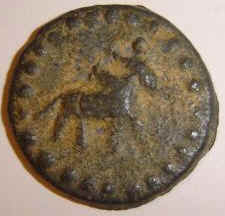
Lead coin from the region around Bago in the south of Burma. The obverse shows a small calf facing to the right. The calf is encircled by a ring of dots. The reverse is blank. This coin is from a series of lead coins featuring animals such as frogs, crabs, shrimps, fish and turtles. The coin dates from the 16th to 17th centuries.
Diameter: 23mm
GBP 10,50 (EUR 15,68), 03-jan-07, ebay, shwenaga
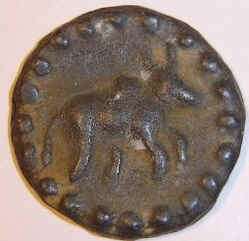
Lead coin from the region around Bago in the south of Burma. The obverse shows a horned bull with a hump facing right. The bull is surrounded by a circle of dots. The reverse is blank. This coin is from a series of lead coins featuring animals such as frogs, crabs, shrimps, fish and turtles. The coin dates from the 16th to 17th centuries.
Diameter:30mm
GBP 12,51 (EUR 18,68), 03-jan-07, ebay, shwenaga
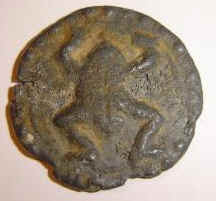
Lead coin from near Bago in the south of Myanmar (Burma). This coin comes from a series of animal coins that includes turtles, crabs, shrimps, cows, fish and crocodiles. The coin dates to the 16th-17th century. The obverse features a frog with splayed limbs in a circle and a ring of dots. The reverse is blank.
Diameter: 29mm
GBP 21,00 (EUR 31,35), 30-dec-07, ebay, shwenaga
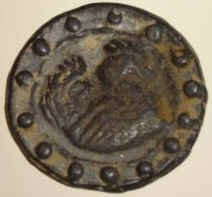
A very rare coin from the southern part of Burma (Myanmar) near the city of Bago. This coin features a plump hantha or chicken with a crest in a circle of dots. The reverse is blank. It comes from a series of coins stamped with birds, although this particular design is scarce and comes from a horde of coins unearthed earlier this year.
Diameter: 44mm
GBP 32,50 (EUR 48,52), 29-dec-07, ebay, shwenaga